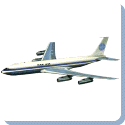 Boeing 707 — Non-military use of jet power attained a new plateau of achievement with the advent of the commercial jet airliner. The highly successful Boeing 707 entered service in 1958. The 707, which was 46. 6 m (153 ft) long and flew at a speed of nearly Mach 1, could carry 200 passengers over transcontinental distances.
Boeing 707 — Non-military use of jet power attained a new plateau of achievement with the advent of the commercial jet airliner. The highly successful Boeing 707 entered service in 1958. The 707, which was 46. 6 m (153 ft) long and flew at a speed of nearly Mach 1, could carry 200 passengers over transcontinental distances.
The Boeing 707 is an American four-engine commercial passenger jet airliner developed by Boeing in the early 1950s. Its name is most commonly spoken as “Seven Oh Seven”. Boeing delivered a total of 1,010 Boeing 707s, which dominated passenger air transport in the 1960s and remained common through the 1970s. As of October 2006, 68 Boeing 707 aircraft (of any variant) were reported to be remaining in airline service, with just two airlines flying passengers, Saha Airlines of Iran and Lade Airlines of Argentina. Boeing also offered a smaller, faster version of the aircraft that was marketed as the Boeing 720.
Although it was not the first commercial jet in service (that distinction belongs to the De Havilland Comet), the 707 was the first to be commercially successful, and is credited as ushering in the Jet Age. It established Boeing as one of the largest makers of passenger aircraft, and led to the later series of aircraft with “7×7” designations
Development
The 707 was based on an aircraft known as the 367-80. The “Dash 80”, as it was called within Boeing, took less than two years from project launch in 1952 to rollout on May 14, 1954. This was powered by the Pratt & Whitney JT3C engine which was the civilian version of the J57 used on many military aircraft of the day including the F-100, F-101, F-102, and the B-52.
The prototype was conceived for both military and civilian use: the United States Air Force was the first customer for the airframe, using it in the KC-135 Stratotanker midair refueling platform. It was far from certain that the passenger 707 would be profitable. At the time, Boeing was making nearly all of its money from military contracts: its last passenger transport, the Boeing 377 Stratocruiser, had netted the company a $15 million loss before it was purchased by the Air Force as the KC-97 Stratotanker.
The 132 inch fuselage of the Dash 80 was only wide enough to fit two-plus-two seating (in the manner of the Stratocruiser). Boeing soon realized that this would not provide a viable payload, so decided to widen the fuselage to 144 inches, the same as the KC-135 Stratotanker, which would allow six-abreast seating – and the shared use of the KC-135’s tooling. However, Douglas had launched its DC-8 with a fuselage width of 147 inches. The airlines liked the extra space, and so Boeing was obliged to increase the 707’s cabin width again, this time to 148 inches. This meant that little of the tooling that was made for the Dash 80 was usable for the 707. The extra cost meant the 707 did not become profitable until some years after it would have if these modifications were not necessary.
The first flight of the first production 707-120 took place on December 20, 1957, and FAA certification followed on September 18, 1958.
Model 720
Boeing would later develop a smaller, faster version of the aircraft that was marketed as the Boeing 720. Between 1959 and 1967, there were 154 models built, hoping to fill the short to medium range commercial market. Other competing aircraft was also in this market with the Convair 880 and 990 aircrafts.
Operational Service
The first commercial orders for the 707 came in 1955, when Pan Am committed to 20 707s and 25 Douglas DC-8s, a dramatic increase in passenger capacity over its existing fleet of propeller aircraft. The competition between the 707 and DC-8 was fierce. Several major airlines committed only to the DC-8, as Douglas Aircraft was a more established maker of passenger aircraft at the time. To stay competitive, Boeing made a late and costly decision to redesign and enlarge the 707’s wing to help increase range and payload. The new version was numbered 707-320.
Pan Am was the first airline to operate the 707; the aircraft’s first commercial flight was from New York to Paris on October 26, 1958. American Airlines operated the first domestic 707 flight on January 25, 1959. Airlines which had only ordered the DC-8, such as United, Delta and Eastern, were left jetless for months and lost market share on transcontinental flights.
The 707 quickly became the most popular jetliner of its time. Its popularity led to rapid developments in airport terminals, runways, airline catering, baggage handling, reservations systems and other air transport infrastructure. The advent of the 707 also led to the upgrading of air traffic control systems to prevent interference with military jet operations.
BOAC 707 at London Heathrow Airport in 1964. In order to become a new major player in the commercial airliner business, Boeing was quick to bend to customer’s desires. While the 707-120 was the initial standard model with Pratt & Whitney JT3C engines, Qantas ordered a shorter body version called the 707-138 and Braniff ordered the higher-thrust version with Pratt & Whitney JT4A engines, the 707-220. The final major derivative was the 707-320 which featured an extended-span wing and JT4A engines, while the 707-420 was the same as the -320 but with Rolls-Royce Conway turbofan engines, making the aircraft more acceptable for the British market. British certification requirements relating to engine-out go-arounds also forced Boeing to increase the height of the tail fin on all 707 variants, as well as adding a ventral fin.
Eventually, the dominant engine for the Boeing 707 family was the Pratt & Whitney JT3D, a turbofan variant of the JT3C with even lower fuel consumption, as well as higher thrust. JT3D-engined 707s and 720s were denoted with a “B” suffix – while many 707-120Bs and 720Bs were conversions of existing JT3C-powered machines, 707-320Bs were only available as new-built aircraft as they had a stronger structure to support a maximum take-off weight increased by 19,000 lb, along with minor modifications to the wing.
The ultimate 707 variant was the 707-320C, (C for “Convertible”) which was fitted with a large fuselage door for cargo applications. This aircraft also had a significantly revised wing featuring three-section leading-edge flaps. This provided an additional improvement to takeoff and landing performance, as well as allowing the ventral fin to be removed (although the taller fin was retained). 707-320Bs built after 1963 used the same wing as the -320C, and were known as 707-320B Advanced aircraft.
As the 1960s drew to a close, the exponential growth in air travel led to the 707 being a victim of its own success. The 707 was now too small to handle the increased passenger densities on the routes for which it was designed. Stretching the fuselage was not a viable option because the installation of larger, more powerful engines would in turn need a larger undercarriage, which was not feasible given the design’s limited ground clearance. Boeing’s answer to the problem was the first twin aisle airliner – the 747. The 707’s first-generation engine technology was also rapidly becoming obsolete in the areas of noise and fuel economy.
Production of the passenger 707 ended in 1978. In total, 1,010 707s were built for civil use, though many of these found their way to military service. Trans World Airlines flew the last scheduled 707 flight for passengers by a US carrier on October 30, 1983, although 707s remained in scheduled service by airlines from other nations for much longer. Middle East Airlines (MEA) of Lebanon flew 707s and 720s in front-line passenger service until the end of the 90s, and now only Saha Airlines of Iran and LADE of Argentina fly 707s in passenger service. Saha’s domestic flights from Tehran to Mashhad, Kish Island and Shiraz are not listed in the July, 2007 Official Airline Guide, however, if still operating. However, Lade flights from El Palomar Air Force Base near Buenos Aires to Rio Gallegos and Comodoro Rivadavia are so listed. The purpose-built military variants remained in production until 1991.
Traces of the 707 are still found in the 737, which uses a modified version of the 707’s fuselage, as well as essentially the same external nose and cockpit configuration as the 707. These were also used on the previous Boeing 727, while the Boeing 757 also used the 707 fuselage cross-section. The Chinese government sponsored development of the Shanghai Y-10 during the 1970s, which was a near carbon-copy of the 707, however this did not enter production.
 Kids Portal For Parents India Kids Network
Kids Portal For Parents India Kids Network
